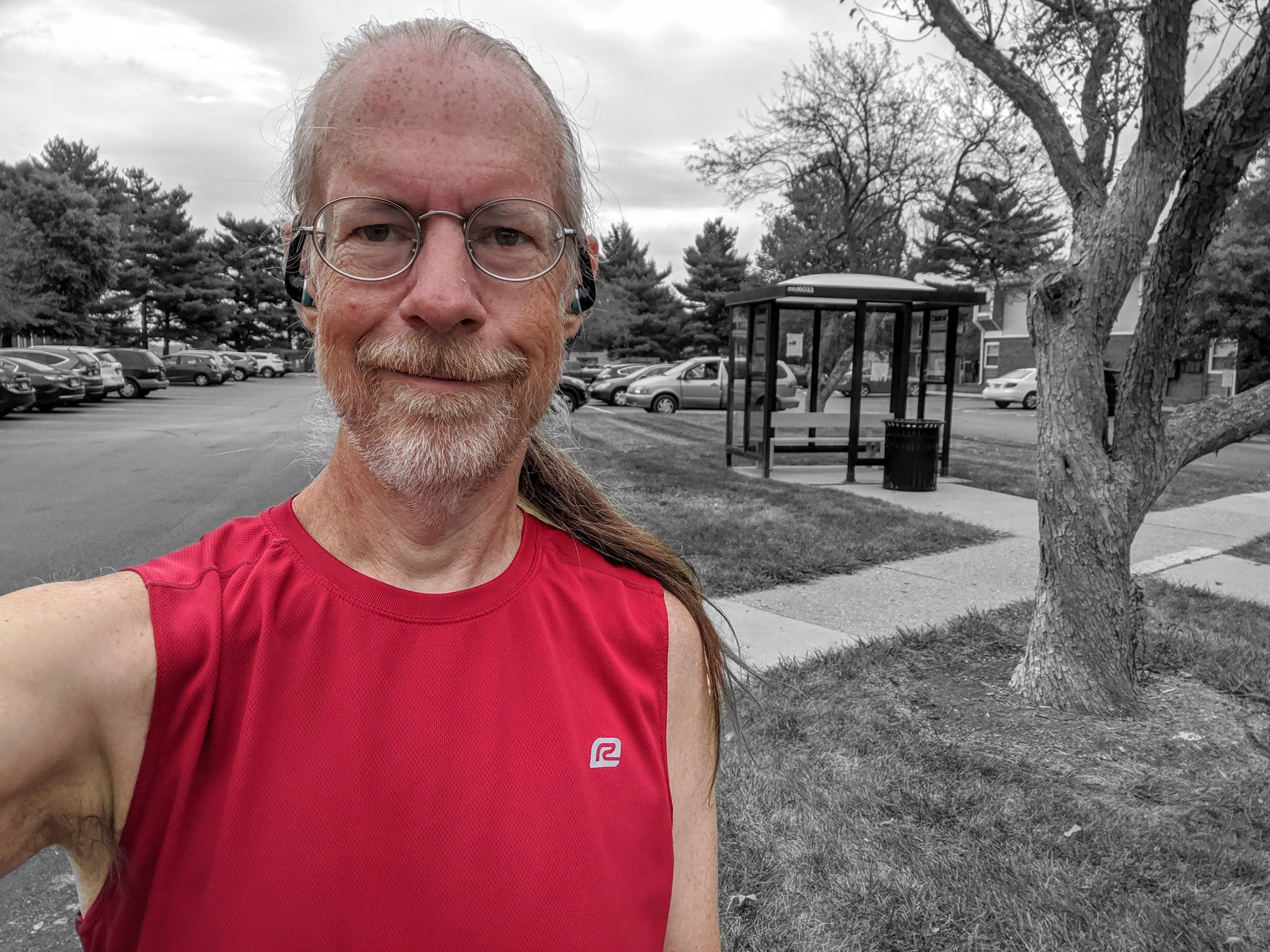
2019-09-21 11:09



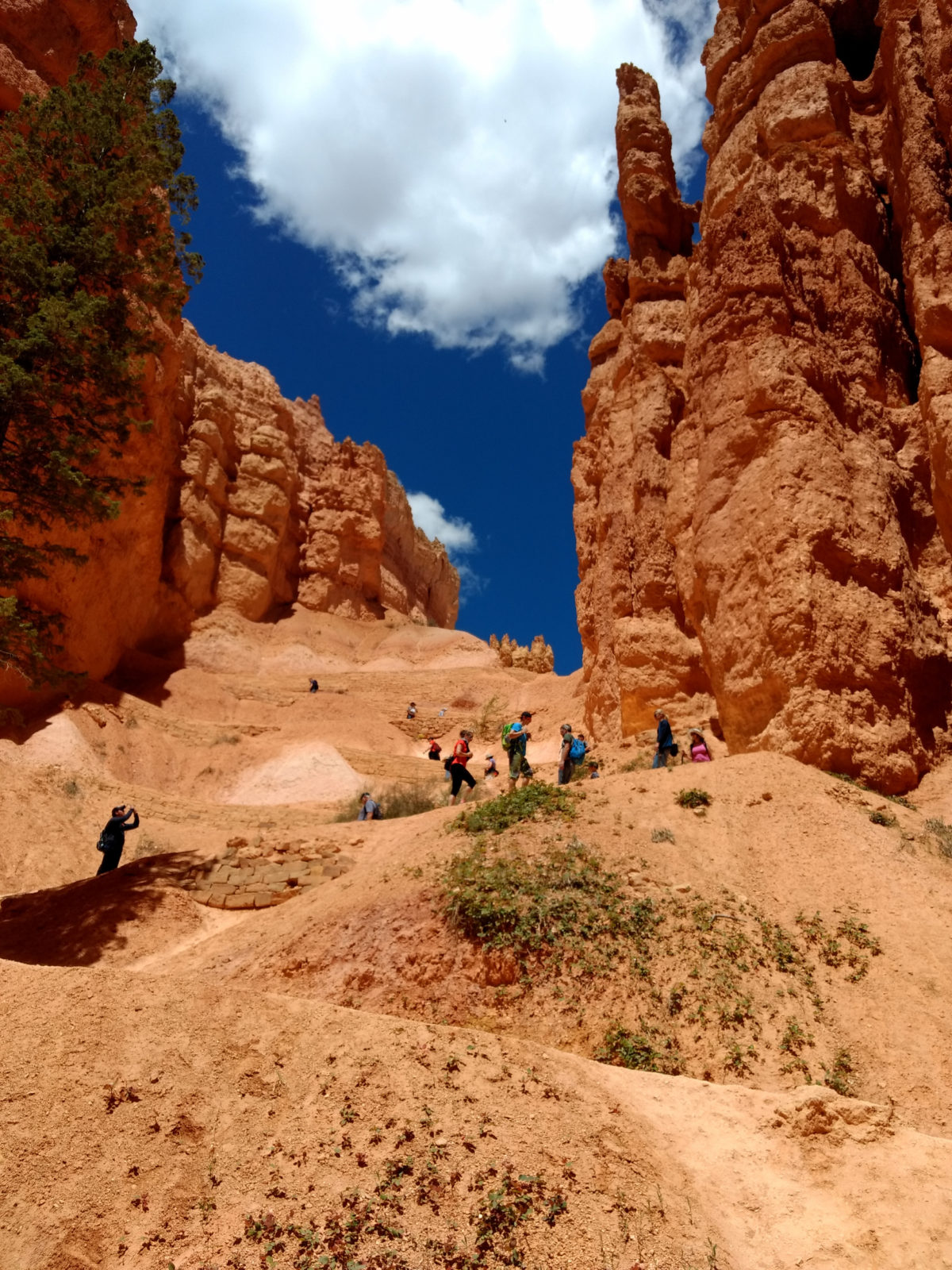
This year’s review of my movement practice will be a bit less detail-oriented than last year’s, when I included a long list of exercises, and a long list of non-exercise movement that I’d engaged in over the year. This year I exercised a bit less and moved a bit more, and came to a balance that I’m pretty happy with—that I don’t feel much urge to analyze.
I continued the winter exercise regimen that I described a year ago for the rest of the winter, but then let most of it go in favor of less-structured movement. As I say, I’m pretty happy with what I ended up doing, although the result was a decline in some of the strength increases I’d made.
Summer included a lot of solo walking (mostly in natural areas very close to home) and a lot of walking with Jackie (in a wide range of environments, including natural areas somewhat further afield).
One major piece of our walking was our big trip to Utah, where we got in plenty of hikes in Bryce Canyon, Zion Canyon, and Arches. (See image at top.) The length of any particular hike was nothing to write home about (although we did write home a bit), but the ruggedness—and especially the steepness—made the hikes very different from anything we manage at home.
Basically, summer was great—lots of time spent in the sun, lots of walking, lots of time spent with my sweetie, lots of time spent alone.
As summer transitioned to fall, I had the same problems I usually do, perhaps slightly worse this year than average because the transition seemed more abrupt, with early fall being unusually cold. Happily, late fall was no worse than early fall, and what was unusually cold for early fall is actually rather mild for early winter.
One thing I have done this fall is get back to running. In the past I’ve always meant to establish a running habit that I can carry forward into the cold months, and I have nearly always failed. This year, so far, I’m doing okay, getting in a couple of runs a week, with long runs of 5 miles or more. With just a little luck (not too icy, not too much bitter cold) I’ll be able to carry a lot more aerobic fitness into the spring than I usually manage. That would make it possible to do a spring running event, if I want.
I’ve had very good luck this year on the injury front, managing to stay healthy though the whole year.
I still teach taiji, both the beginners class and a class for continuing students, and it remains rewarding it all the ways it has been—physically (I get my own taiji in), mentally/emotionally (I get my meditation in), socially (I gather with a group of friends several times a week), and financially (admittedly in a small way).
Looking ahead, I’m rather inclined to stick with a movement focus, spending more time doing stuff (moving) and less time preparing to do stuff (exercising).
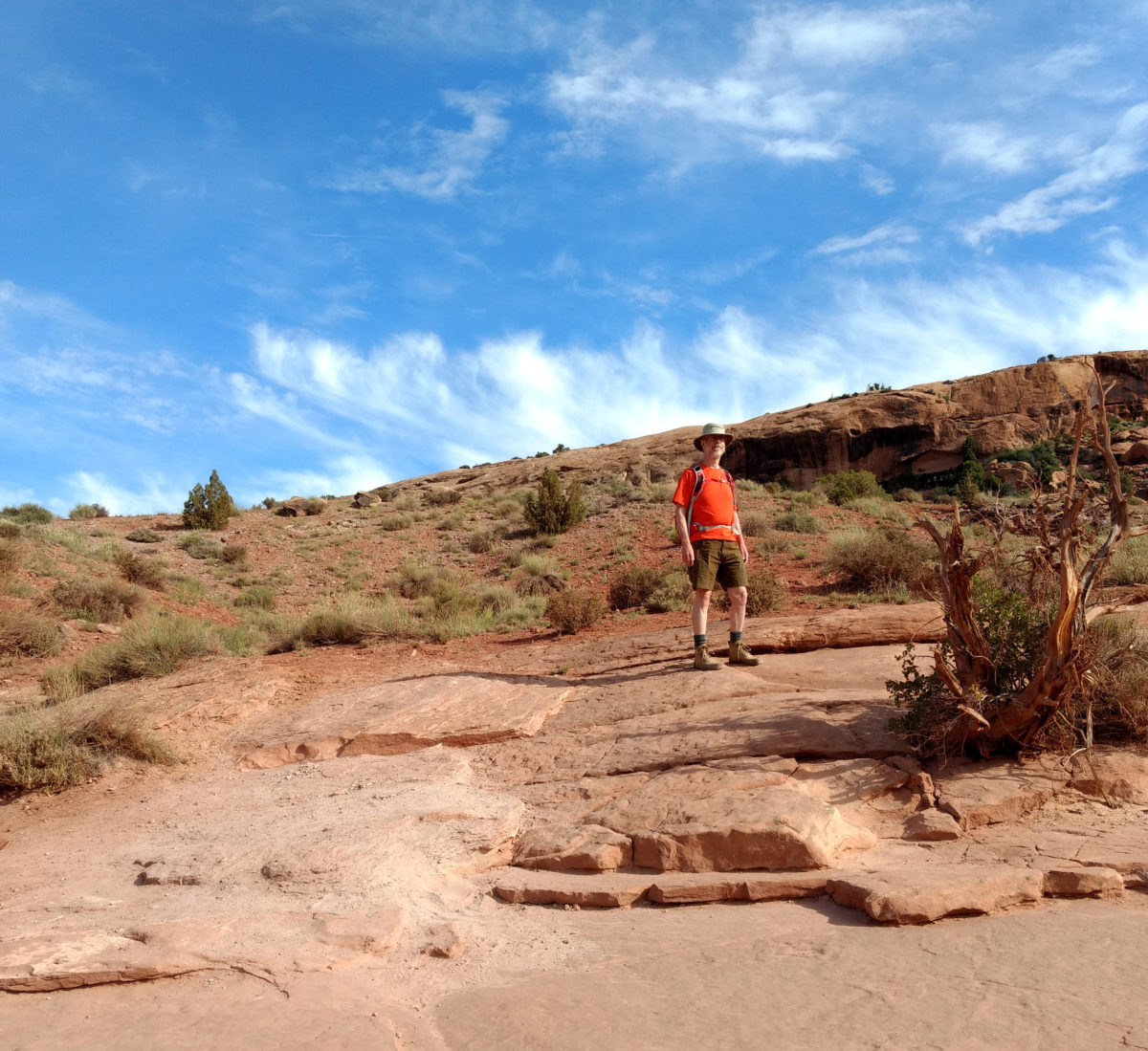
I have always enjoyed exercising in the heat. In this I seem to be different from most people.
I originally took note of this fondness back in the early 1980s when I was living in Ft. Lauderdale. A ritzy local tennis club—way too expensive for me—offered summer memberships for just $100. I just got access to the outdoor courts and not to the indoor amenities, but all I wanted was a place where I could reserve a court and know that it would be available when I met someone there. The only downside was that you were playing tennis outdoors, in the summer, in Ft. Lauderdale. And it turned out I was okay with that.
I’m pretty careful not to be stupid about it. (And successfully so, it seems—I’ve never gotten heat exhaustion or heat stroke.) If I start feeling tired, thirsty, or overheated, I slow down, move to the shade, and drink some cold water.
Over the years I’ve had a variety of theories about why I didn’t mind exercising in the heat when other people hate it so much. I like to imagine that I’m just better at tolerating the heat than the average person: Everyone slows down in the heat, but maybe I slow down slightly less; at some high temperature, maybe I’d become competitive! More likely, since I’m not competitive I’m not making unfavorable comparisons between my speed in the heat versus my speed in cool weather, so the fact that I slow down doesn’t make me unhappy.
Recent research has given me a new, much more likely reason why I like exercising in the heat. On Rhonda Patrick’s Found My Fitness podcast, I heard an interview with Dr. Charles Raison, in which he described the results of a study suggesting that Whole-Body Hyperthermia was an effective treatment for depression. The experiment used infrared lights to heat people up to a core body temperature of 38.5℃ (101.3℉), but Raison is convinced that there is nothing special about the device used, and that a sauna, hot spring, sweat lodge, hot yoga—or just exercising in the heat—would have the same antidepressant effect.
Dr. Raison is studying further to try to elucidate the mechanism by which hyperthermia boosts mood in depressed people. (It seems to reduce inflammation, perhaps by boosting IL-6 which activates IL-10. Heat Shock Proteins might also be involved, since they do all sorts of things.)
I have always been inclined to blame a lack of daylight for the seasonal depression that I’m prone to suffer from during the winter—both too short of a photo-period (which I address with a HappyLight™) and too little vitamin D (which I address with vitamin D supplements), but it now occurs to me that a lack of opportunity to exercise in the heat (and thereby raise my core body temperature high enough to trigger whatever it is that reduces depression) may be an independent factor.
It seems very likely that, just like my desire to spend time outdoors in daylight is probably self-medicating to boost my vitamin D and regulate my circadian rhythm, my desire to exercise in the heat is probably self-medicating to boost my mood.
I hesitate to rejoin a fitness center just to get access to a sauna, but I’ll have to investigate options for access to winter whole-body hyperthermia.
I’m pretty pleased with 2017 on a movement front. As I sat down to write this, I had been feeling a little discouraged about how slow my progress seemed on the strength front, but when I looked back at where I was one, two, and three years ago, I can see that I’m actually making steady progress. (And, after I’d started drafting this post, I managed to do a chin-up, so I’m especially pleased about that.)
I feel like I’ve pretty much managed to internalize my realization that movement trumps exercise. I certainly don’t move enough, but I’m much more inclined to notice now whenever I do something that minimizes or outsources my movement. This gives me a chance to say, “Never mind. I’ll go ahead and do that myself.”
Since I don’t move enough, I have to add exercise to the mix. Especially in the winter, when the cold and the dark and the ice make it tough to fit all the movement in, I exercise. And I pick my exercises with the goal of improving the capabilities—mobility (especially), strength, control and access to appropriate movement patterns—that I found were limiting factors last summer.
This last—access to movement patterns—is new. I’m just coming to realize that in many cases my limitations are not (or not entirely) a lack of strength or flexibility, but rather are due to poor patterning of the movement. More on that below.
I stuck with the exercises I’ve been focusing on for three years now, and added a couple.
I finally made real progress in squatting, and it turned out to be a really simple thing that made the difference—and probably a movement pattern thing.
In one of the classes I took with Ashley Price, she had us find the best squat we could do with perfect form. That is, we got in neutral posture with our feet hip width apart, our feet pointing straight forward, our femurs neutral, and then we squatted down only as far as we could go while keeping our shins vertical.
My discovery was that by first getting as far down as I could with my shins vertical, I was in a posture that let me easily lower down the rest of the way into a deep squat. It’s not a perfect deep squat (I wouldn’t want to load up my back with a heavy weight and lift it) and it’s not quite to where I can comfortably rest at the bottom of a deep squat (although it is getting pretty close), but it is now a useful capability. For example, on the last day of the year I got down in a deep squat to look over the choices in our liquor cabinet, and ended up lingering there for some little time. (The range of choices is rather large just now, thanks to a generous gift and a bit of splurging on our own.)
Basically, I’m happy with my progress on squatting.
Here I’m finally making great progress—chin-up!
Other than that I’m pretty much doing what I’ve been doing—negative pull-ups. Sometimes I do them for volume (I’ve done as much as 3 sets of 7, or 2 sets of 8 plus a few). Other times I’ve been doing many fewer sets and reps, concentrating instead on doing them very slowly.
Just since doing my chin-up I’ve begun to recognize a movement pattern issue here as well. Based on how sore my traps were after my first chin-up, while my lats weren’t sore at all, I think I’m failing to initiate the pull with my lats. I’m addressing that two ways. First, I’m doing the negative pull-ups very slowly, trying to find the point where I transition to using my lats and emphasize that part of the move. Second, I’m trying to specifically engage the lats by pulling my shoulders back and down before trying to pull myself up.
Besides all that I’m sticking with my other hanging exercises—swinging side-to-side and back-to-front, leg raises, knee-ups, and I’ve added some twisting knee-ups as well, turning my hips to alternate sides and raising my knees toward my elbow on that side. I’m also ready to start doing some traversals along the bar.
I haven’t made much progress here, for much the same reasons as last year: wall dips are hard, and I’ve been working on various progressions instead. I play around with bench dips and (rather shallow) parallel bar dips and wall supports.
Another reason I’m not making much progress here is that for my main pushing exercise I’ve been emphasizing pushups.
I’m reasonably pleased with my progress on toe flexibility as well, even though I haven’t actually increased my range of motion much. What I’ve done is improve my ankle dorsiflexion enough that I’ve been able to start doing the things I couldn’t do because of limited toe flexibility.
There’s a particular move I wanted to be able to do, that involved shifting from a squat to a deep knee bend, then lowering the knees to the ground and then kneeling. It can also be reversed by flexing the ankles to tuck the toes under, rocking back to get into a deep knee bend, and then shifting to a squat for standing back up.
Among other things, this is a martial arts move: You can move from kneeling to standing while keeping your hands free to block an attack (or prepare to launch one).
I can sorta do that now. Not smoothly, and not without an amount of toe stretching that feels a bit excessive, but vastly better than two years ago where a single attempt hurt my knees and toes enough that it took weeks to recover.
As I said, instead of dips I’ve instead been focusing on pushups. I’ve made good progress here as well: I can now do 8 pushups (up from 1 a little over a year ago). I’ve also greatly improved my form—keeping my elbows tucked in close to my sides, rather than letting them flair out as I’d probably done since I was a kid in gym class. (Your humeri should be neutral with your elbow pits pointed forward.)
Now that I can do 8 pushups it’s about time to start doing multiple sets—maybe starting with 2 sets of 5? I’ll try that in a couple of days.
I don’t have long-term plans to emphasize pushups though. I’ll keep doing them, but once I can do a couple of sets of pushups and still have some strength left in my triceps, I’ll get back to work on the various sorts of dips.
This year I added kettlebell swings to my exercise regimen. I want to talk about this a bit, because there’s a story here.
About a year and a half ago I was out on a very long walk with Jackie. Toward the end we sat down on some concrete benches for a short rest, and I found that there was an uncomfortable lump right behind where I was sitting. Shifting around to find a lumpless spot was not successful. Eventually I figured it out: I had lost enough weight that I no longer had enough cushioning to keep my tailbone up off the bench; the lump I felt was my coccyx.
Figuring that bigger glutes would be a better choice for keeping my coccyx up off the bench than fat anyway, I started boosting the weight I used in my goblet squats. Then I remembered an old post by Tim Ferris that recommended kettlebell swings as the best glute exercise. Then some anonymous kind soul donated a 45 lb kettlebell to the Winfield Village fitness room.
Looking at my training log, it appears that I started doing kettlebell swings in January, and worked up to 3 sets of 25 by April. As Tim had recommended 75 reps as a target, I’ve left it there. I don’t have data on the size of my glutes, but I’m no longer bothered when I sit on a hard bench.
I use the kettlebell swings as my high-intensity interval training as well. A set of 25 swings spikes my heart rate up right toward my max heart rate. (I’ve actually seen heart rates above my estimated max heart rate, which just means that the estimate is a bit off.) Each set takes about 50 seconds, and I follow it with as much rest as I need to get my heart rate back down around 100, which works out to two or three minutes.
I’ve toyed with the idea of adding a fourth set, and might yet do that.
My main non-exercise movement is and always has been walking. It was a bit limited in the second half of this year because I hurt my feet, and one foot in particular has taken a long time to recover.
I think what happened was this: I was waiting for the bus, which unbeknownst to me had been rerouted due to road construction. Seeing the bus zip past a block away, I took off running to try to catch it at the next stop. In the rush I think I must have fallen into an old heel-strike movement pattern, bruising my heels, resulting in this nagging foot pain. Only in the last few days of the year does it seem to finally be completely resolved.
I still walk a good bit for transportation, just less than I was doing before I hurt my feet. I’ve also done less walking with Jackie since she started working at Great Harvest bakery. (This does not mean less walking for her—she walks to work most days.)
I expect my walking quantity to return to its old baseline quantities in the new year.
Running was also curtailed by my foot injury. Before I hurt my foot I had been increasing my running distances as well, working my way up to where I did an 8-mile run for the first time in many years.
Some of my running is exercise, but a good bit is movement (as, for example, the sprint to catch the bus where I injured my feet.)
I did spend a little time with the campus parkour club, but once again timidity (both movement timidity and social timidity) kept me from doing as much as I might have.
Each summer I mean to step this up. Maybe 2018 will be the year.
For most of the year I teach two taiji classes—a beginners class that meets for an hour twice a week, and a group practice for continuing students (we don’t consider ourselves “advanced”) that meets for an hour three times a week. Besides that I do some taiji and qigong throughout most days. I do some qigong to loosen up in the morning. I do some before lifting to warm up, and then I do some between sets as “active recovery.” I might do a whole short form when I feel like a little moving mediation would do me some good, or even a whole long form when I feel like a lot of moving meditation would do me some good.
Basically, I do a lot of taiji.
Even when I’m not teaching I include it as part of my daily movement, simply because it has proven itself such a powerful tool for helping me move and feel better.
Over the summer I got back together with my friends who practice push hands a few times, but we were never able to get a regular thing going, which is very sad. I’ll try again next summer.
I have continued my practice of joining Jackie for occasional stewardship work days at natural areas in and around Urbana. (I even did one without Jackie—a prairie burn.)
These are perfect examples of non-exercise movement: We don’t do them for the exercise (although we get plenty); we do them to improve the land.
They are very satisfying for many reasons—doing hard work with friends is always satisfying, contributing to the community (making the parks better) doubly so. I think an additional reason is that the actual physical movements and mental activity that we do while locating and removing invasive plants is virtually identical to those that our hunting-and-gathering ancestors must have done for most of the past two hundred thousand years. (I see now that I made exactly the same point last year.)
With one possible exception, my plans for the new year don’t include big changes, just continuing progress. (The possible exception is treating myself to a month pass to Urbana Boulders and putting my new upper-body strength to work climbing walls.)
I have had some success in getting my mind right with the cold, this year in particular, but also gradually over the past several years. I’m getting in more outdoor exercise this year than last, and a lot more than I did five or ten years ago. That, plus the indoor strength training and the taiji, look to stand me in good stead for getting 2018 off to a good start.
We’re planning a spring trip to some national parks in southern Utah which will entail a good bit of walking, so we have that bit of extra motivation to keep up with our walking over the winter.
Happy New Year!
This year didn’t have a stunt like last year’s Kal-Haven Trail walk. Instead I tried to spend the year turning my realization that “getting plenty of exercise” is a poor substitute for “moving all day” into something that guided my behavior all the time.
I did not have perfect success. I still spend too many hours sitting at my computer during the day, and then spend too many hours sitting and watching videos in the evening. Neither did I fail. I included movement throughout the day most days of the year, especially through the spring, summer, and fall.
Although movement was my focus I certainly did not give up on exercise. In particular, I used exercise to make progress on developing certain capabilities that I lack.
I had four specific things I was going to work on for 2016: squatting, toe flexibility, hanging, and wall dips. I made good progress on all them except the toe flexibility.
My limitations in squatting turn out to be almost entirely mobility. (My personal test for this is the goblet squat. Using a modest weight—just enough to serve as a counterbalance so I can get down into a deep squat—I can do a dozen reps.)
The other ways (besides a counterbalance) to compensate for squat-limiting mobility issues are heel bolstering, hanging onto something in front of you, and taking a wide-legged sumo stance. I don’t practice the last, but use it when I want to look in my mailbox (which is down low) or into a low cabinet or the bottom of the refrigerator. I don’t much practice hanging onto something while squatting either. Most of my practice has focused on bolstering.
With a modest amount of heel-bolstering I can now get down into a deep squat, and linger there comfortably. Almost every day I do my calf and hamstring stretches and then do some squatting with progressively lower heel bolstering. I haven’t done as much hip flexor stretching as I probably need to. I’ll add that to my daily routine, both for the stretching itself, and also for the motor control practice—I’m kind of wobbly doing a hip flexor stretch, which probably causes all the related muscles to tighten up some.
My hanging is probably where I’ve made the most progress. I can now hang for long enough (90 seconds) that there’s time to do stuff while hanging—things like swinging back-and-forth or side-to-side, pulling my knees up toward my chest, or raising my legs up in front of me.
To just hanging I added negative pull ups. After an ill-advised increase in volume hurt my shoulder in July I eased up just a bit, but still made good progress, working up to 3×5 negative pull ups.
When that turned out not to have enabled even one pull up, I changed the exercise just a bit: Now I’m doing the negative pull ups even slower, trying at each point to see if I can (from that point) lift myself up, or at least stop my descent.
Soon. Soon I will be able to do a pull up.
I thought I was ready to do wall dips a year ago, because I could do wall supports—support myself with my hands on the top of a wall. I could even sort-of do one wall dip—lowering myself and then pushing back up.
I didn’t train that exercise enough in the summer, largely because I didn’t have a good wall to practice on. When I came back to it in the fall, I found that going from one wall dip to two wall dips was quite challenging.
Something that is well-known in the bodyweight exercise community—that I know, but always seem to have trouble applying to myself—is that when an exercise is too hard you should back off to an easier progression.
So, just now that it’s winter, I have finally backed off a bit to an easier dip progression: bench dips (where you have your hands on a bench behind you, with your legs stretched out in front of you, and you lower and raise yourself with your arms while some weight rests on your heels).
I’ve already worked up from 1×8 bench dips to 1×12. Pretty soon I’ll be doing 3×12. Then it’ll probably be time to return to wall dips. I’ll also keep up with my wall supports, when I happen upon a good wall.
The area where I’ve made the least progress is toe dorsiflexion. That’s been kind of frustrating.
This may be one area where what I need is not just more stretching (which hasn’t seemed to do any good at all) but some sort of deeper tissue work to break up adhesions, recover space in the joint capsule, etc.
It just now, while writing this, occurred to me that I probably I need to expand my focus to include my whole foot and not just the toes. So that can be my winter practice: the same, plus extra foot mobility.
I’m adding a fifth area of focus for 2017: Pushups.
They had not been a priority before, because pushing strength in that plane is not particularly important for parkour. And yet, it’s such a basic exercise, it seems silly not to give it a little attention—particularly because I was actually really weak in that area: I could barely do one pushup.
I just decided to add pushups a few weeks ago, about the same time I figured out I should back off from wall dips to bench dips. So when I found I could barely do a pushup, I quickly realized that I should back off to something easier for that move as well. So I’ve just started doing bench pushups (hands on a bench, rather than on the floor). I can do 1×8 of those as well.
Because trying to do a pushup is so easy, I probably won’t wait until I can do 3×12 bench pushups before switching back to regular pushups; I’ll just include an occasional few (as many as I can do) in the mix. Once I can do 5 or 6, I’ll switch back to actual pushups.
Without a stunt walk to work up to, Jackie and I did not walk as much this year as last, but we did plenty of long walks and at least one very long walk. Some of our walking is exercise, but most of it is either just a way to get places, or else companionable social time together—often both.
I also did a good bit of running, especially before August. As I’ve been doing more and more these past two or three years, I skipped most of the short and medium runs, letting walks stand in for those, and just did the long runs. That worked surprisingly well, and in July I did a 7.25 mile run, my longest run in years. This is probably a slider as to whether it counts as “exercise” or not, but I do it as much because I enjoy it as I do it for fitness, so I think it legitimately goes here.
Early in the summer I did some training with the campus parkour group, which was great fun. I found it a bit stressful: I’m not strong enough to do some of the basic moves, and I’m too timid to commit to some of the ones I could do if I’d just go for it. I quit going in July when I hurt my shoulder, and then never got started again. I will go back. Maybe being stronger will help some with the timidity as well.
I’ve continued to teach taiji, and to do taiji for myself when I’m not teaching it. The qigong practice that we start each session with provides a pretty good mobility routine (although lacking in the things I mention above: hip flexion, ankle dorsiflexion, and toe dorsiflexion). It builds strength (especially leg strength), balance, and precision (matching movement to intention). It includes a meditation practice—in each class we sit for a few minutes and stand for a few minutes, as well as trying to approach the form itself as moving meditation. It fills so many rolls it goes way beyond exercise (although it’s that too).
One new thing I added—perhaps the most fun of all—is push hands. Closely related to taiji and qigong, it’s kind of a transitional step between taiji as a moving meditation and taiji as a martial art. It deserves a post of its own, so I won’t try to describe it here, and instead just thank the new friends I’ve been able to push with and say how much I’m looking forward to practicing again now that the holidays are over.
This doesn’t really describe a category of movement at all, which is I guess the way in which this is totally not an exercise.
Jackie’s master naturalist program includes a substantial volunteer commitment. It can be met a lot of different ways, but one is working in the various parks, doing things like clearing invasive plants, planting native species, and so on.
I’ve just done a few of these, but spent a couple of hours each time moving. Some of the movement—in particular, gathering prairie seeds—must have been identical to what our ancestors would have done in gathering seeds. Others were perhaps slightly different—we had saws and pruning clippers that our earliest ancestors would not have had—but once something has been cut, the lifting and dragging is right back to being the exact same movements that humans have been doing for hundreds of thousands of years.
I’m always torn this time of year, between looking forward to spring and being able to move outdoors again, versus motivating myself to get outdoors anyway (also: finding ways to move more indoors). I’m trying to discipline myself not to just defer my plans to the spring even implicitly such as by saying “I’m looking forward to spring and being able to move outdoors again.”
I’m pleased with 2016, a year of great progress in my movement practice, and I have every reason to hope that 2017 will be even better.
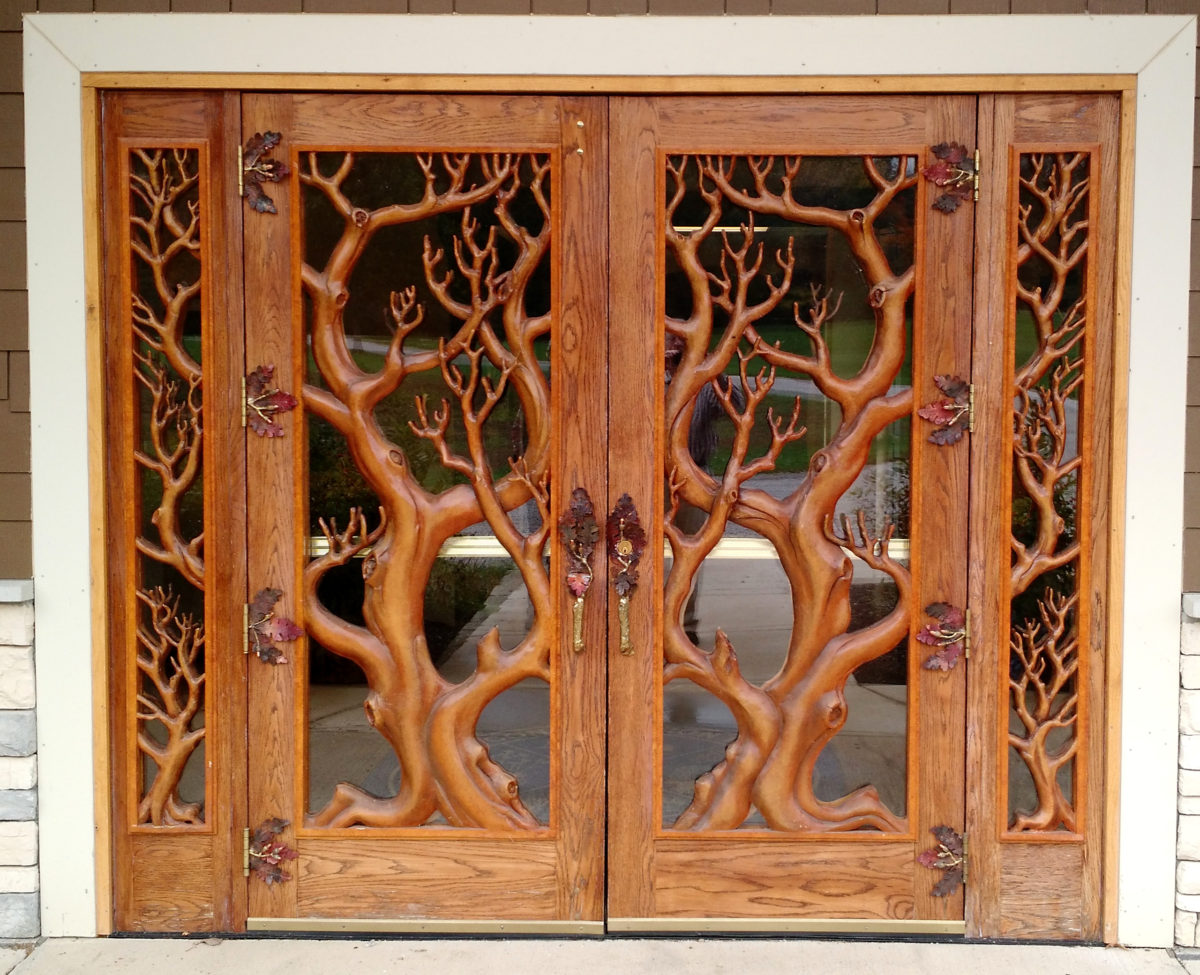
Even though I’m finding my self-care regimen for seasonal depression pretty adequate these days, I’m always interested in more tools. One thing that caught my attention recently was an interview with Brant Cortright in which he talked about his book The Neurogenesis Diet and Lifestyle.
Cortright has a bunch of interesting things to say, one of which I already knew: that depression is not a disorder of serotonin deficiency. According to him—and this I did not know—the way SSRIs work is by promoting neurogenesis. In the interview he said that depression turns out to be caused by a lack of neurogenesis, as are several other disorders (e.g. Alzheimer’s).
I checked the local libraries for copies of his book without success, but in my searches I happened upon this article: Successful brain aging: plasticity, environmental enrichment, and lifestyle by Francisco Mora, which seems to cover pretty much the same ground.
People are looking very hard at drugs besides SSRIs to promote brain plasticity, but the whole idea sounds problematic to me, so I’m interested in the various non-drug interventions suggested by Cortright and Mora. Fortunately, it seems that neurogenesis is easy to increase, by doing the obvious things we already know about:
I think of my artist dates in particular as environmental enrichment, but of course time spent in nature counts as well. The parkour I do probably counts double, because there’s learning how to execute the moves, but there’s also learning to see the environment as a place where those moves are useful.
My weight loss practices have been substantially motivated by the science around calorie restriction as a way to improve health generally, with additional neurogenesis just one factor.
My experience over the previous 30 years convinced me that approaching calorie restriction in a numerical, analytical fashion—tracking what I ate, estimating the calorie content, aiming for some target X% below maintenance—would be unsuccessful. Instead, I came at it from the other direction: If I’m losing weight, I must be restricting my calories.
The caloric deficit implied by my weight loss over the past five years is just about 100 calories per day. Maintenance for me is probably around 1800 calories per day, so I’ve averaged about 5.5% below. It would probably be more accurate to say that I’ve averaged about 10% below maintenance for about half that time, as I’ve generally lost weight during the summers while maintaining a stable weight through the winters. Either number is well shy of the “20% to 40%” reduction that’s been shown to decrease the rate of aging of the brain, but I rather suspect that the benefit exists even at these lower levels—with the added bonus of being sustainable over a much longer period of time. (I mean, how long can you maintain a 40% deficit below maintenance before you simply waste away?)
According to Mora, aerobic exercise seems to increase neurogenesis by the same chemical pathways as calorie restriction. According to Cortright, it has to be aerobic activity of substantial duration—some twenty minutes or more. In particular, the sort of HIIT workouts so beloved of the paleo/primal folks don’t seem to produce the same effect. That’s fine with me: Humans are much too well-adapted for endurance running for me to buy into the idea that primitive humans didn’t do marathon-distance runs when they needed to. Besides, I enjoy long runs.
Of course, neurogenesis is reduced by the obvious things:
My parents made a considerable effort to keep me and my brother free of neurotoxins, and I have managed to avoid concussions so far. I’m sure I subjected myself to excessive blood glucose levels for years, but I think I’ve got that under control now. I also subjected myself to excessive levels of stress for years, due to the vicious circle of my seasonal depression making me unproductive, my lack of productivity making me stress about losing my job, and the stress no doubt worsening my depression. I’ve got that under control now as well.
Really then, this whole neurogenesis thing doesn’t so much give me new strategies for staving off depression, as provide a conceptual framework for organizing the strategies I’m already using.
Even just that seems worthwhile.
(The image at the top is of these great doors at the Environmental Education Center at Kennekuk County Park. The branching trees reminded me of neurons, a little.)

There’s a dearth of good walking routes from Winfield Village to Champaign and Urbana.
From west to east, the choices are Prospect, Lyndhurst/Fox Drive, Neil/Route 45, First Street, and Race Street. The first two are okay if we’re heading to western or central Champaign, but are pretty out-of-the-way if we’re headed to campus or to Urbana. The latter two lack sidewalks and entail long walks along busy roads, which makes them pretty unsatisfactory.
A few weeks ago, I saw a pack of cross-country runners turn up a rather faint double-track on this side of the railroad, which alerted me to the fact that it’s possible to go that way.
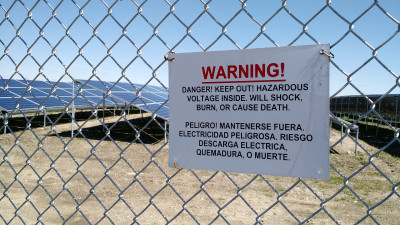 I was doubly interested in going that way, both as a possible alternative route north, and because about one mile north of us there’s a large installation of photovoltaic panels that the University has been calling its “solar farm,” and this bit of double-track leads right to it.
I was doubly interested in going that way, both as a possible alternative route north, and because about one mile north of us there’s a large installation of photovoltaic panels that the University has been calling its “solar farm,” and this bit of double-track leads right to it.
The track runs along the west side of what seems to be research crop fields for the University, although that bit of it may be an easement to provide access to a recently constructed line of pylons for some high-tension power lines.
The solar farm seems to producing quite a bit of electricity on sunny days like today.
Having walked to the solar farm we turned east. Having come that far instead of having to walk a mile along First Street, we only had a quarter of that distance to cover before we reached Windsor and were able to get on a proper sidewalk.
We took a nice tour around the more obscure corners of the research park, including a little diversion past the Fire Service Institute’s training facilities. Then we crossed Route 45 and made our way down to Schnuck’s to pick up a couple of groceries and head on home.
Total walking was 7.7 miles, in my case added to a 3.5-mile morning run.
I had not done much running since settling into the low-carb thing. Together with the walk, it’s a bit of a test of whether I’m seeing any of the endurance benefits I’m hoping to see. (Answer: Maybe. I certainly didn’t get hungry or feel a need to fuel up during the walk. But then, neither did Jackie.)
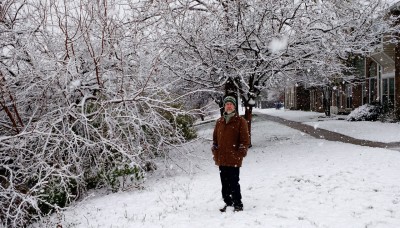
Seven or eight years ago, I became aware of research that suggested that vitamin D deficiencies were a possible cause of seasonal depression. As I have long suffered (albeit mildly) from SAD, I figured it was worth trying a vitamin D supplement, and it did seem to help.
I worry just a bit about taking a supplement, because there are dangers with excessive doses of vitamin D. (A random site on the web suggests that doses over about 10,000 IU per day are dangerous, if continued for a period of months.)
So, I prefer to get my vitamin D via sunlight. A pale-skinned person like me can make upwards of 10,000 IU of vitamin D in just a few minutes of mid-day summer sun—but there’s no danger of getting an overdose: your skin keeps making it as long as you’re in the sun, but once saturated with an optimal amount, it starts un-making it as fast as it makes it.
But it’s the UVB light in the sun that makes the vitamin D, and at my latitude (I live at almost exactly 40° north), little or no UVB gets through the atmosphere during the winter. Specifically, the vitamin D window closed this year on November 20th. It’ll open again on January 20th—although of course it’ll be too cold to expose much skin to the sun for a month or two after that.
This past summer, I spent more time in the sun than in years past, and found that it made me feel especially good—like the opposite of seasonal depression. I imagine it’s the extra vitamin D, although I don’t see any way to tweeze evidence for that hypothesis out from the many other possible reasons. Perhaps it was just more bright light (as opposed to the UVB in particular)—surely the sun is the world’s best light box. Perhaps it was just being more active (I tend to get my sun walking or running, not sitting or lying in the sun). Perhaps it was the endocannabinoids produced during the longer runs in particular. Perhaps it was more time in nature (I spend a lot of my outdoor time walking or running in our local prairie and woods), which is known to be good for the mood. Perhaps it was the extra “together time” Jackie and I got on our very long walks. Perhaps it was the solitude of walks and runs by myself, providing space for meditation.
Whatever it was, I miss it in the winter, and I fixate on a vitamin D deficiency as a possible culprit. Maybe I’ll up my supplement dose. Of course, I won’t do just that. I’ll use my Happy Light™. I’ll go for long walks in the cold and snow. I’ll get out in the prairie and the woods. I’ll try to cover all the possibilities. But I’ll keep taking my vitamin D.
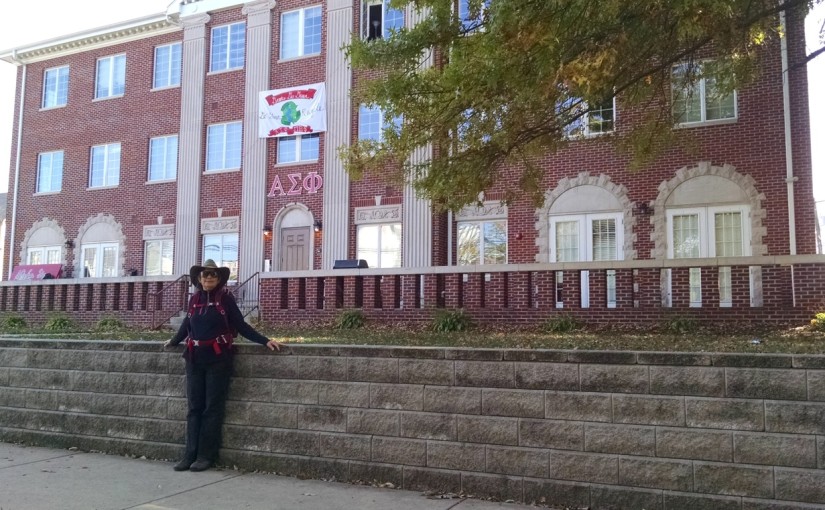
Since our big Kal-Haven trail walk in June, we’ve continued to walk, but we haven’t gone on many long walks—and in particular, haven’t gone on any very long walks.
What’s the boundary between ordinary long walks and very long walks? I choose to set an arbitrary dividing line of 14 miles. This is because Jackie and I, by merest happenstance, turn out to each remember having walked 14 miles as our “longest hike ever” in the years before we’d met.
It was with all that in mind that I suggested a couple of days ago that we should go for a 15-mile walk today.
I had in mind more than just ticking off the “very long walk” box. With winter coming, I want to be sure I don’t start thinking that ordinary winter weather is a reason not to go for a long walk. It was chilly this weekend, so I thought a good opportunity to ease our way in to walking in the cold. There are also scheduling issues that’ll make it hard to get a very long walk in during the next week, so it seemed today was our big chance.
It was a wonderful day for a walk—beautiful, clear, sunny weather, crisp in the morning, but reaching 60 in afternoon. We walked up First street to the research park, then turned east and walked along the south end of the Arboretum and through Orchard Downs, before turning south again so we could take a turn through Meadowbrook Park. Then we headed back north along Vine as far as downtown Urbana, so we could have lunch at Crane Alley. (Good beer. I had a Deschutes cinder cone red on nitro. Jackie had an ESB, although I forget which one.) From there we headed west toward campus, headed back south to have coffee at Espresso Royale, then meandered through campus, crossed the railroad tracks and Route 45 to head south along the Boulware path, stopping at Schnucks to get some half&half and tomato paste.
The total distance came in at 14.62 miles, comfortably over the line into “very long walk” territory by my standards.
I didn’t take many pictures, but I did get this one of Jackie in front of the Alpha Sig frat house, Chuck McCaffrey’s old fraternity. This would have been along about mile 10 of our walk.
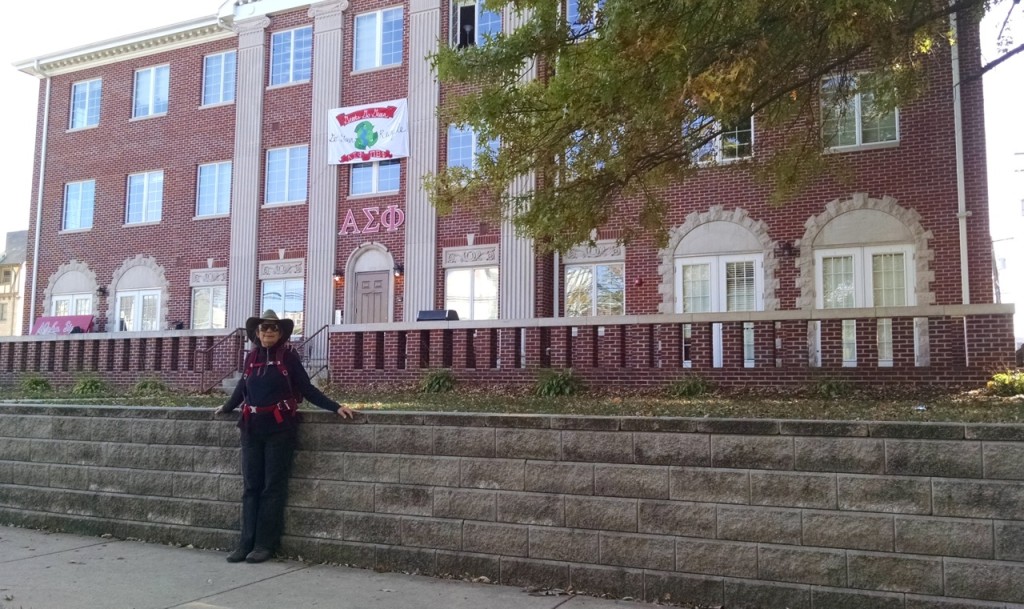
Oh, and I wanted to mention that I wore my new boots! I bought a pair of Lems Boulder Boots, minimalist-style boots that I got with an eye to being my main winter boot this season. I got them five or six weeks ago, and have worn them as my everyday boot for most of that time, but this was their first try on a very long walk. Fortunately, they worked great.

In line with what I’ve been saying for years now, today The Well has a report of new research supporting the hypothesis that endocannabinoids are much more likely to be the source of runner’s high than endorphins. (See my endocannabinoids tag for previous posts.)
The gist of the experiment was to give mice running wheels, and then measure both mood (anxiety levels, as shown by a willingness to linger in light areas, as opposed to staying in the dark) and blood levels of endocannabinoids and endorphins. Then they used drugs to selectively block receptors for cannabinoids. Doing so eliminated any observable anxiety-reduction effects from running. Blocking receptors for endorphins had no such effect.
The study itself: A runner’s high depends on cannabinoid receptors in mice.
In keeping with earlier research on this effect, the amount of running it takes to see a strong endocannabinoid effect was substantial—the mice were running more than 3 miles a day. I don’t know how far three mouse miles is in human miles. Earlier research suggested that 50 minutes of running was sufficient in humans.
So the subtle upshot of the new study may be that we should run. And if we don’t feel a high, perhaps try running more, until eventually a gentle euphoria may settle in and we can turn to our running companion and say, “Ah, my endocannabinoids are kicking in at last!”
I should probably find some running companions to share this with. I almost always run alone, and it seems like my endocannabinoids kick in just about exactly when I no longer feel any urge to wonder about whether they’re going to kick in or not.
Here’s one of the paths through the prairie where I run: